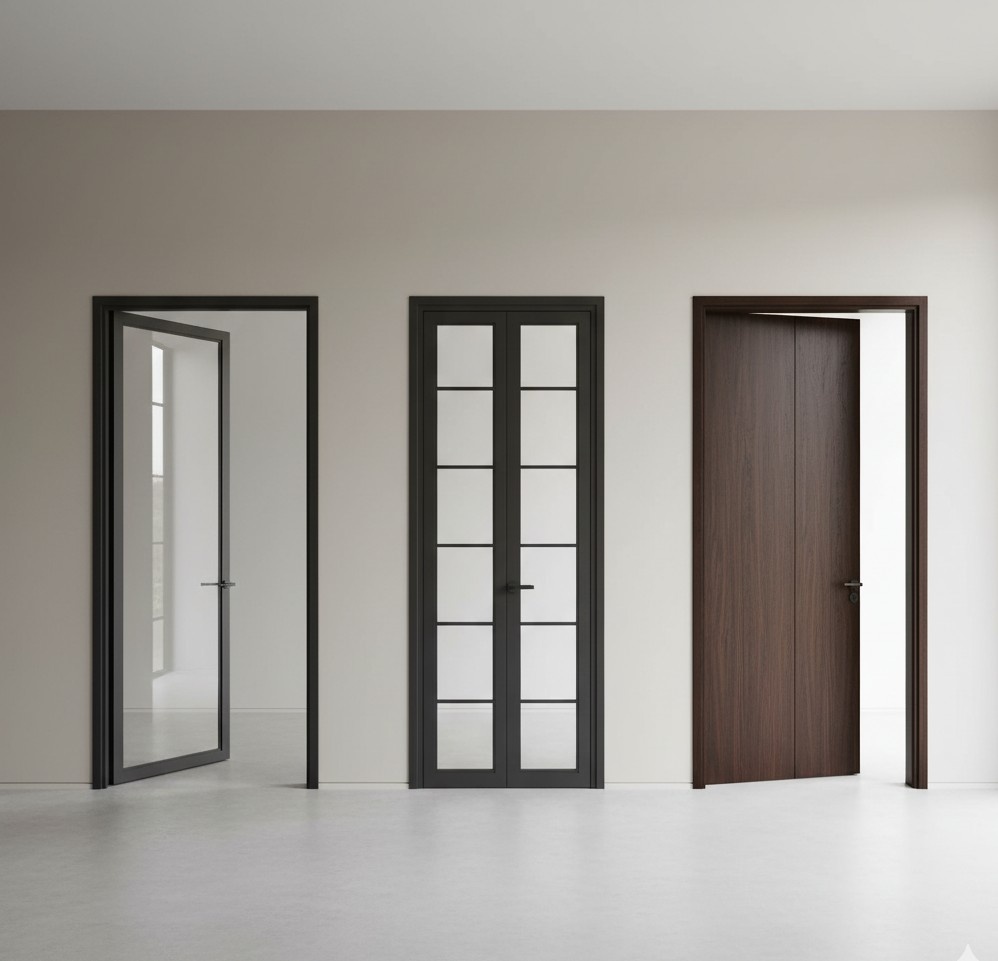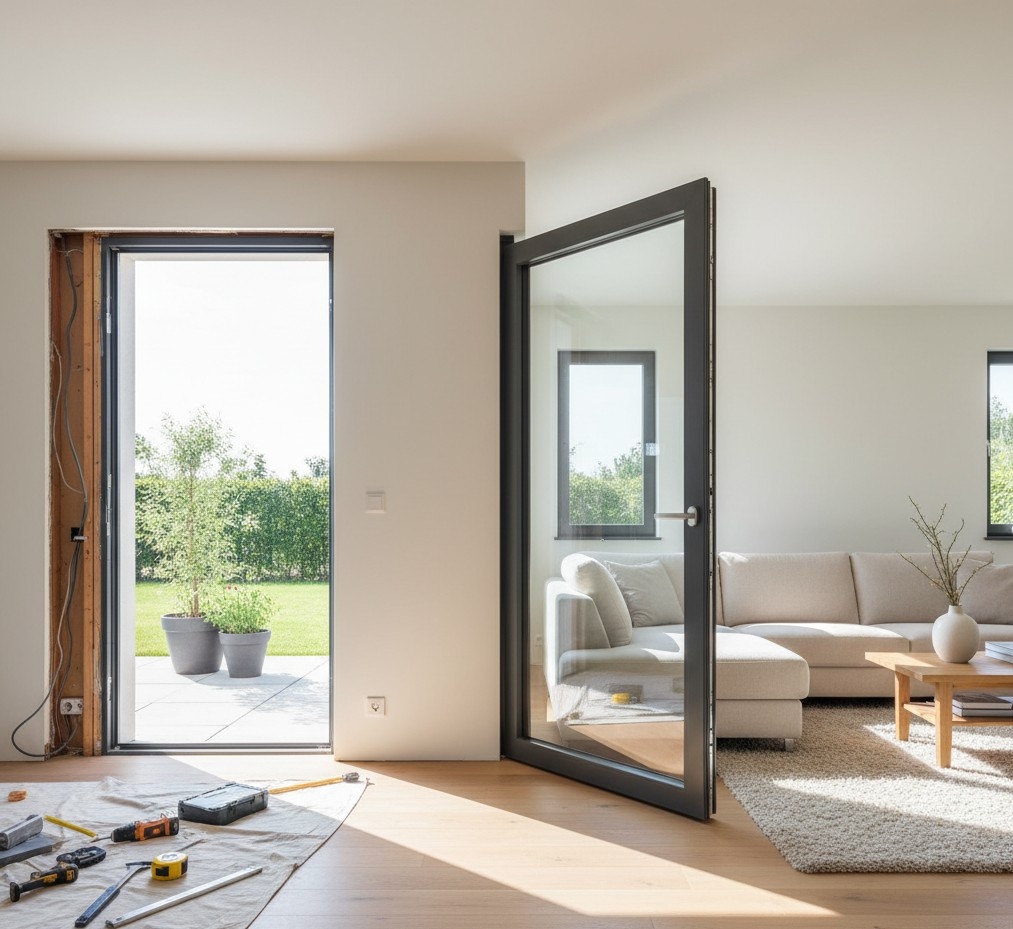Replacing a sliding door with a swing door can dramatically improve both the functionality and style of your home. Sliding doors are convenient in smaller spaces, but over time they can suffer from track jams, poor insulation, and weak security. Swing doors, in contrast, bring stronger sealing, a classic aesthetic, and more versatile hardware options.
For homeowners planning this transition, understanding every step from design choices to installation details is essential. This guide explains the entire process, including cost estimates, common challenges, and considerations when sourcing high-quality door systems.
Why Replace a Sliding Door with a Swing Door?
Homeowners often replace sliding doors because they become harder to operate or less energy-efficient with age. Tracks gather debris, rollers wear out, and gaps compromise insulation. Swing doors provide a sturdier, longer-lasting solution while improving overall home value.
Key Motivations for Replacement:
- Improved energy performance with tighter seals
- Stronger locking systems for added security
- Greater design flexibility for interiors and exteriors
Comparing Sliding Doors vs Swing Doors
|
Feature |
Sliding Doors |
Swing Doors |
| Space Requirement | Slides along track, minimal clearance | Needs swing clearance |
| Maintenance | Tracks prone to dirt and jams | Hinges require occasional oiling |
| Energy Efficiency | Often leak air | Seal tightly, higher efficiency |
| Security | Simple latches | Multipoint locks available |
| Style Options | Mostly glass-heavy | Available in wood, aluminum, fiberglass |
Many homeowners find that while sliding doors are convenient, swing doors offer greater durability and long-term value.

Planning Your Door Replacement Project
Assessing Your Home Layout
Before conversion, check the surrounding wall space. Swing doors require clearance for the leaf to open fully, which may affect furniture placement. In compact areas, French or pivot-hinge doors may be a better fit.
Structural Considerations
Sliding door openings are often wider than single swing doors. This means you may need double swing or French doors to fill the same space. Reinforcing or resizing the frame may also be necessary.
Budgeting the Project
The budget should include not only the door itself but also hardware, installation labor, and finishing touches such as trim or sealant. Unexpected adjustments to flooring or siding can also increase costs.
Conversion Process: From Sliding to Swing
Tools You’ll Need
- Measuring tape
- Pry bar
- Power drill and screwdriver
- Level
- Shims
- Hinges and swing door hardware
- Caulk and weatherstripping
Taking Proper Measurements
Measuring correctly ensures the new swing door fits securely. Always measure the rough opening’s width, height, and depth, checking for squareness. Confirm that there is enough space inside or outside for the door to swing without obstruction.
Measurement Checklist
- Width and height of rough opening
- Frame depth vs. wall thickness
- Swing clearance (inward or outward)
Step-by-Step Tutorial
- Remove sliding panels from the track.
- Take out frame and tracks using a pry bar.
- Check opening for level and squareness.
- Install swing door frame with shims for alignment.
- Attach hinges securely to frame and door.
- Hang the door leaf(s) and test movement.
- Seal gaps with caulk and weatherstripping.
- Check locks and handles for smooth operation.
Tip: Test the swing multiple times before final caulking to ensure smooth clearance.
Cost & Time Estimates
| Option | Estimated Cost | Average Time | Notes |
| DIY | $300–$800 | 6–10 hours | Best for standard wood or prefab swing doors |
| Professional | $1,000–$3,500 | 1–2 days | Ideal for aluminum doors or custom work |
Labor rates vary by region, while material choice significantly impacts overall cost.
DIY vs Professional Help
| Approach | Pros | Cons |
| DIY | Cost savings, personal satisfaction | Risk of misalignment, no warranty |
| Professional | Fast, code-compliant, guaranteed | Higher upfront expense |
DIY is fine for straightforward projects, but large aluminum or multi-panel systems are best handled by professionals.

Design & Style Options for Swing Doors
Types of Swing Doors
- Single Swing – Simple, practical for entryways
- French Doors – Double doors, stylish for patios or living areas
- Pivot Doors – Modern look, dramatic wide openings
Material Choices
- Aluminum – Durable, lightweight, low-maintenance
- Wood – Traditional, but prone to warping and requires upkeep
- Fiberglass/Composite – Energy-efficient, weather resistant
- Steel – Excellent security for main entry doors
Hardware & Accessories for Swing Doors
Choosing durable hardware ensures longevity and smooth operation. Hinges should be heavy-duty, especially for aluminum or oversized doors. Locking systems can include deadbolts or multipoint mechanisms for added safety.
Must-Have Components:
- Hinges
- Handles and levers
- Multipoint locks
- Thresholds
- Weatherstripping
Common Challenges During Conversion
Alignment Issues
If the opening is not square, the door may sag or not seal properly. Shimming is essential for correcting uneven frames.
Weatherproofing
Sliding tracks often leave gaps when removed. Filling voids with flashing tape and caulk prevents air or water leaks.
Structural Adjustments
Some projects require resizing or reinforcing the opening, which may involve additional carpentry. This is where professionals add significant value.
Safety, Compliance & Certifications
Swing doors should meet energy efficiency and safety standards. Certified products guarantee compliance with local and international building codes.
Manufacturers like Oridow supply certified doors and windows that meet global standards for performance, making them a reliable choice for both residential and commercial installations.
Cost Breakdown in Detail
|
Component |
DIY Estimate |
Professional Estimate |
|
Door unit |
$200–$600 | $500–$1,200 |
| Frame & hardware | $100–$250 | $200–$400 |
| Labor | – | $500–$1,500 |
| Finishing | $50–$150 | $150–$400 |
| Total | $350–$1,000 |
$1,200–$3,500+ |
Choosing a Reliable Door Manufacturer
Why Quality Matters
Poorly made doors can warp, rust, or lose efficiency within a few years. High-quality swing doors and sliding windows extend lifespan and improve comfort.
Why Professionals Choose Oridow
- Based in China, serving international markets
- Offers aluminum swing doors, sliding doors, and custom window systems
- Holds certifications for energy efficiency and safety compliance
- Works with wholesalers, builders, architects, and developers globally
FAQs
1. Can a sliding door be converted into a swing door?
Yes, a sliding door can be converted into a swing door if the opening is structurally sound. The process involves removing the old track and frame, squaring the opening, and installing a new hinged frame. In most cases, homeowners can choose between single, French, or double swing doors depending on the width of the opening.
- Remove panels and tracks first
- Square and reinforce the opening
- Install a new swing frame and hardware
- Choose door type (single, French, or double)
2. How much does it cost to replace a sliding door with a swing door?
The cost depends on door material, labor, and complexity. DIY projects may cost as little as $300, while professional installations with aluminum or custom doors can exceed $3,500.
- DIY projects: $300–$800
- Professional installation: $1,200–$3,500+
- Material factor: Aluminum and composite cost more than wood
- Extra costs: Finishing, trim, and sealants
3. Are swing doors more secure than sliding doors?
Swing doors are generally considered more secure because they support stronger frames and advanced locking systems. Sliding doors often rely on simple latch mechanisms, while swing doors can use multipoint or deadbolt locks.
- Multipoint locks provide added resistance
- Heavy-duty frames resist forced entry
- Hinges with security pins prevent removal
- Better sealing reduces prying risks
4. How much space do I need for swing doors?
Swing doors require clearance equal to the width of the leaf, plus a few inches buffer for comfortable operation. This means you must check interior and exterior space to avoid furniture or wall obstructions.
- Inward-swing doors need interior space
- Outward-swing doors need patio/walkway clearance
- French doors require double the swing clearance
- Pivot doors offer flexible swing ranges
5. Can French doors replace sliding doors?
Yes, French doors are a popular replacement for sliding doors since they fill the same wide opening. They provide a more elegant aesthetic and better insulation, making them suitable for patios and living areas.
- Ideal for patio-to-living room transitions
- Adds charm and elegance to interiors
- Can be double-glazed for energy efficiency
- Works well in both modern and classic homes
6. Which material is best for swing doors?
The best material depends on your priorities: durability, budget, or aesthetics. Aluminum is highly durable and low maintenance, wood offers a classic look, while fiberglass and composites provide excellent insulation.
- Aluminum: Modern, durable, corrosion-resistant
- Wood: Traditional, but high maintenance
- Fiberglass/composite: Low maintenance, energy-efficient
- Steel: Strongest for entry security
7. Should I DIY or hire a professional for the conversion?
If you’re confident with carpentry and have the right tools, DIY is possible for standard wooden doors. However, complex installations, especially aluminum or large custom doors, are best left to professionals for proper sealing and compliance.
- DIY: Lower cost, good for basic frames
- Professional: Ensures accuracy and code compliance
- Custom/oversized doors: Strongly recommend professional help
- Warranty protection: Often only available with professional installs





